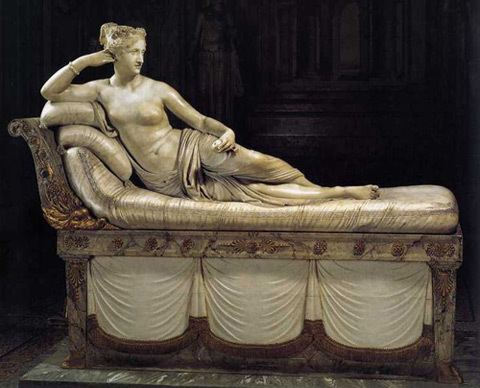Year 1805-1808 Created 1808 | ||
 | ||
Similar Antonio Canova artwork, Artwork at Galleria Borghese, Other artwork | ||
Pauline Bonaparte as Venus Victrix (or Venus Victorious) is a semi-nude life-size reclining neo-Classical portrait sculpture by the Italian sculptor Antonio Canova. Reviving the ancient Roman artistic traditions of portrayals of mortal individuals in the guise of the gods, and of the beautiful female form reclining on a couch (as most often seen in reclining portrayals of Hermaphroditi), it was commissioned by Pauline Bonaparte's husband Camillo Borghese and executed in Rome from 1805 to 1808, after the subject's marriage into the Borghese family. It then moved to Camillo's house in Turin, then to Genoa, only arriving in its present home (the Galleria Borghese in Rome) around 1838.
The sculpture
Nude portraits were unusual, subjects of high rank usually having strategically placed drapery (though Canova did produce another of the Bonaparte family, with his 1806 Napoleon as Mars the Peacemaker). It is a matter of debate as to whether she actually posed naked for the sculpture, since only the head is a realistic (if slightly idealised) portrait, whilst the nude torso is a neo-classically idealised female form. When asked how she could pose for the sculptor wearing so little, she reputedly replied that there was a stove in the studio that kept her warm, though this may be apochryphal or a quip deliberately designed by her to stir up scandal.
She holds an apple in her hand evoking Aphrodite's victory in the Judgement of Paris. The room in which the sculpture is exhibited at the Galleria Borghese also has a ceiling painting portraying the judgement, painted by Domenico de Angelis in 1779 and inspired by a famous relief on the façade of the Villa Medici.
Canova was first instructed to depict Pauline Bonaparte fully clothed as the chaste goddess Diana, but Pauline insisted on Venus. She had a reputation for promiscuity, and may have enjoyed the controversy of posing naked. The subject of the sculpture may have also been affected by the Borghese family's mythical ancestry: they traced their descent to Venus, through her son Aeneas, the founder of Rome.
The wooden base, draped like a catafalque, once contained a mechanism for rotating the sculpture, as in the case of other works by Canova and in the adapted bases of ancient sculpture in galleries, so that a viewer could observe it from all angles without moving him/herself. In the era of its production, viewers would also admire the sculpture by candlelight. The sculpture's lustre was not only due to the fine quality of the marble but also to the waxed surface, which has been recently restored.
